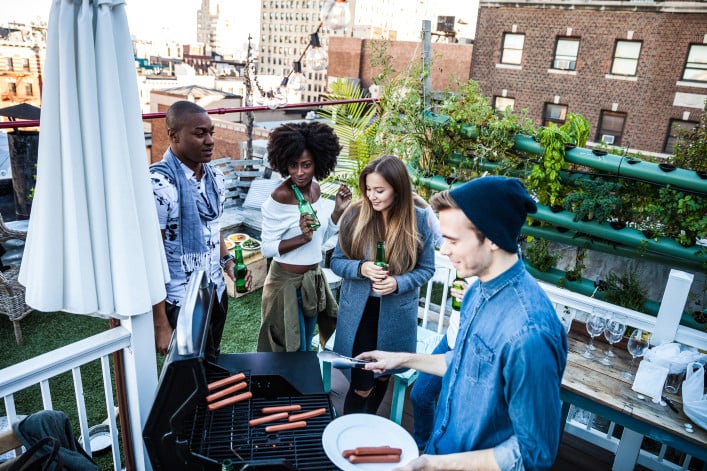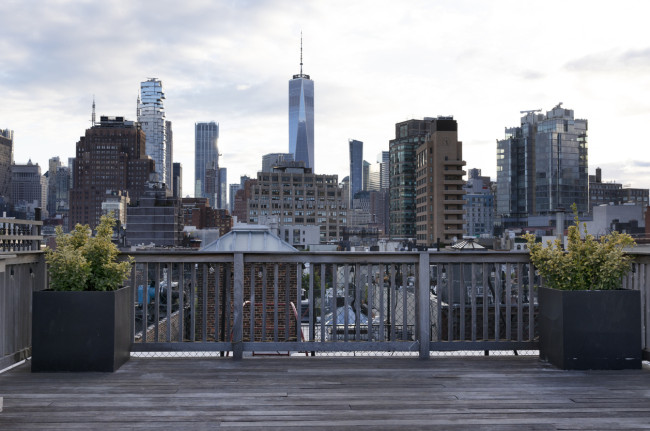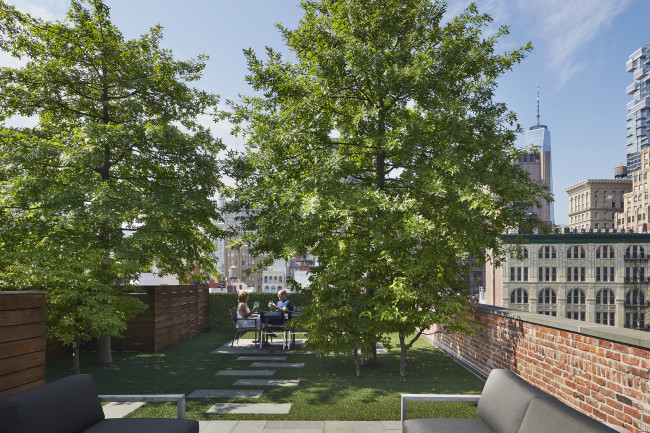How much does private outdoor space add to the price of a NYC apartment?
- One square foot of outdoor space is roughly equal to 25 to 50 percent of the price per square foot for the unit
- About 22 percent of co-ops and condos that sold in Manhattan in the last 12 months had outdoor space

The value of a private outdoor space depends on a lot of factors, including how much you're able to use it.
iStock
New York City apartments don’t come cheap, but ones with private outdoor space—such as a balcony, terrace, or roof deck—can sell for thousands of dollars more than a unit without.
One way to calculate the value of outdoor space is to examine it in relation to the price per square foot of the apartment’s interior space, said Jonathan Miller, president and CEO of appraisal firm Miller Samuel.
The value of one square foot of outdoor space is about 25 or 50 percent of the price per square foot for the apartment, Miller said. So to find out how much a patio or terrace adds to the price of a co-op or condo, you multiply the total square footage of the exterior space by 25 to 50 percent of the price per square foot for the apartment. (The size, usability, and views of the outdoor space determine whether you would use the top end of the range or the bottom).
For example, if you have an apartment that costs $1,500 per square foot, then a 500-square-foot terrace could add as much as $750 per square foot to the total purchase price, Miller said. That amounts to a whopping $375,000, or $750 per square foot multiplied by 500 square feet.
That rule of thumb still applies, even after the pandemic made outdoor space more appealing, Miller said. Apartments with outdoor space are easier to market and sell, but the way they are valued hasn’t changed, he added.
“Units with outdoor space have an advantage, especially in this post-pandemic era where outdoor space became a more sought after factor,” Miller said. “But we’re still not seeing the valuation methodologies change.”
Roughly 22 percent of apartments that sold in Manhattan in the last 12 months had outdoor space, more than the 14 percent of apartments with outdoor space that sold in 2017, Miller said.
[Editor’s Note: A previous version of this article ran in May 2018. We are presenting it again with new information for May 2024].
Other methods to measure an outdoor space's value
UrbanDigs, a real estate analytics firm, uses a slightly different formula to value outdoor space, but one that gets roughly the same result as Miller, said Noah Rosenblatt, CEO of UrbanDigs, during a webinar on Sept. 22nd last year.
UrbanDigs tacks on $50,000 to $75,000 to the valuation of an apartment with a balcony under 100 square feet. For terraces and gardens, it adds between $200 and $600 per square foot for spaces that range from 100 square feet to over 500 square feet, depending on the space’s utility and size relative to the apartment.
So for example, a 375-square-foot terrace attached to a one-bedroom apartment would add around $186,875 to the value of the unit. But a small terrace of around 150 square feet on a one-bedroom apartment would only tack on $83,750.
UrbanDigs’ formula, like Miller’s, depends on the apartment, view, design, and utility of the space, and who the prospective buyer could be.
"No outdoor spaces are alike," Rosenblatt told Brick Underground. "Differences in utility include the quality of the terrace condition itself, ease of access to the apartment, amount of natural sunlight, quality of views, depth of the space, etc. Defining if the outdoor space is of low, medium, or high utility will allow us to determine if we should lean higher or lower for the price range per square foot multiplier."
Not all outdoor space lures buyers
Not all outdoor space is created equally; bad views, for example, can turn off a buyer just as a gorgeous open terrace can get one interested, said Kinnaird Fox, a broker at Sotheby’s International who has sold apartments in Manhattan, Brooklyn, and Queens.
“In my experience, the quality of the outdoor space really is what determines the overall price of a specific apartment,” Fox said.
Outside space has a greater impact on prices at the higher end of the market, “than in smaller apartments, where buyers are more concerned with staying under a maximum price point,” said Jason Halpern, founder and managing director of JMH Development, a Brooklyn development company.
Read on for an overview of the three types of outdoor space you can expect to find in NYC, and how they could impact the price of your unit.
How to price a balcony
Balconies—which jut out from the building above the ground below—tend to be smaller than terraces, with more limited use as a platform for plants, to store a bicycle, or to enjoy a cup of coffee on. But the small space also adds less of an expense to the final price point, offering an aesthetic bonus on a budget.
Still, a tiny balcony with a poor view can actually turn a buyer off, Fox said.
“You can have a very small, barely usable balcony that looks out onto the interiors of other buildings; there's not a tree in sight, it's not very attractive, and no one really wants to go out on it. That's not going to add value,” Fox said.
“But if you have a usable space that's off of the living areas, the dining room, the kitchen, that can be used for entertaining and by the owners of the apartment, that has a lot of value and is very desirable,” she added.
How to price a terrace
Unlike balconies, terraces recede into a building and can be much larger, and more appealing. Terraces can more easily accommodate tables and chairs—or even a barbecue grill if you’re so lucky.
But terraces can also be so large that they turn off buyers. In general, terraces that are bigger than half the size of the apartment itself add minimal value to the unit and can actually end up costing a buyer more over time, even if it doesn’t change the purchase price.
Here’s how: Outdoor space can be factored into the number of shares you have in a co-op, increasing your monthly maintenance costs, Miller said. A large terrace on a relatively small apartment can hike monthly fees for buyers that have limited budgets, he added.
“You're dealing with a studio buyer and all of the sudden they have outsized maintenance for a large, outdoor space, and the ability to use it doesn’t offset the [additional maintenance costs],” Miller said.
How to price a private or shared roof deck
Private roofs might require a little shimmying up a ladder or a narrow staircase to access the space, making them less appealing for older owners. But accessible spaces can be very attractive to New Yorkers who want their very own spot for grilling, tanning, and hosting in the warmer months.
JMH Development’s building at 70 Henry St. in Brooklyn Heights, for example, includes a penthouse apartment with a 2,500-square-foot roof deck. One big benefit of the rooftop is the “expansive views,” Halpern said.
You could always build your own roof deck on your townhouse, if you own one, but that type of project usually comes with a gut renovation that can cost thousands (or even millions) of dollars.
On the other hand, you could always buy an apartment with a shared roof deck, though you’ll have to follow your building’s rules on using it. So sorry: no smoking or Speedos.
It’s tricky to determine how much a shared roof deck adds to the purchase price of an individual unit, Miller said. Usually, building amenities come as a package deal—there might be a roof deck, gym, and a pool all under (and on top of) the same roof, making it difficult to isolate the impact of the roof deck alone.
How to price a backyard or patio
Yards and patios typically offer little or no view, but have the allure of allowing for a real planted garden. You can finally touch grass at home (or at least a shrub).
Yard space comes at a premium in Manhattan but tends to be more plentiful in the outer boroughs. But make sure you know your neighbors before you pay up for a yard.
Take it from Brick writer Paul Reynolds: “I once rented an East Village townhouse with a charming back porch and patio adjacent to a community garden that hosted an evangelical group on Saturday afternoons. It was hard to use my own space then because of highly amplified testimonials to the power of Christianity to cure addiction.”
—Earlier versions of this article contained reporting and writing by Paul Reynolds.






























